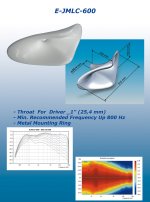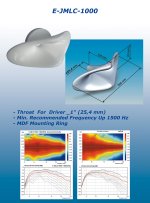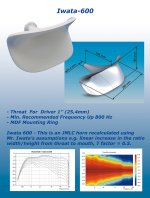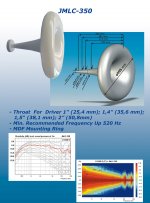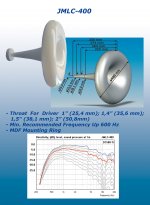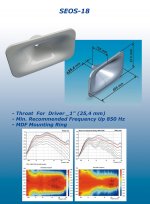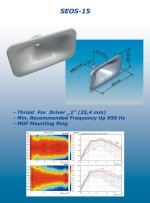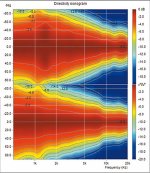Quick but of research on the horns. Here are the data sheets for a selection. This is to help me out a bit.
The respnse curves I assume that smoother is better and the ones that drop off at higher freq will need some form of lift or another UHF driver?
To me the little Iwata 600 or the big ol' E-JMLC 600 look to be the best? Am i reading this right?
Oh, and can someone explain how the read the pretty coloured ones
The respnse curves I assume that smoother is better and the ones that drop off at higher freq will need some form of lift or another UHF driver?
To me the little Iwata 600 or the big ol' E-JMLC 600 look to be the best? Am i reading this right?
Oh, and can someone explain how the read the pretty coloured ones

Attachments
Last edited:
Okay
For the response graphs, the many traces, consecutively reduced in level, represent the response at many points away from directly in front of the horn; varying degrees off axis. A horn with a response that stays the same shape but falls in magnitude as you move off-axis has controlled directivity. It means that the sound doesn't change in tone as you move away from directly in front, it simply gets quieter. The horns don't have control over their entire range however, as it's related to their dimensions. As you get lower in frequency they will tend to lose control and the pattern widens.
The pretty, colourful graphs are 'polar', and are showing much the same information but in more detail.
Instead of, say, 0, 5, 10, 15, 20 degrees off axis, etc, as in the response graphs, they show a continuum. Bass frequencies are at the left end, treble at the right. 90 degrees to one side of the horn is at the top, and 90 to the other is at the bottom, and the colours represent intensity.
Take the Seos-15 polar graphs; the horizontal shows the the sound is projected over a beam of constant width between about 1.5kHz and 16kHz. It's slightly narrower at 1k, which means that when you're 50 degrees off axis, 1kHz will sound quieter than other frequencies. Above 16k, again the horn loses control and there will be little 18k+ past around 30 degrees off axis.
The vertical plot can be read exactly the same way but it represents above/below the directly-in-front point rather than side-to-side. You can see that the horn has little directivity control vertcally; as you stand up and sit down in front of it, the mid-highs will fall off and then come back in but the high treble won't.
For the response graphs, the many traces, consecutively reduced in level, represent the response at many points away from directly in front of the horn; varying degrees off axis. A horn with a response that stays the same shape but falls in magnitude as you move off-axis has controlled directivity. It means that the sound doesn't change in tone as you move away from directly in front, it simply gets quieter. The horns don't have control over their entire range however, as it's related to their dimensions. As you get lower in frequency they will tend to lose control and the pattern widens.
The pretty, colourful graphs are 'polar', and are showing much the same information but in more detail.
Instead of, say, 0, 5, 10, 15, 20 degrees off axis, etc, as in the response graphs, they show a continuum. Bass frequencies are at the left end, treble at the right. 90 degrees to one side of the horn is at the top, and 90 to the other is at the bottom, and the colours represent intensity.
Take the Seos-15 polar graphs; the horizontal shows the the sound is projected over a beam of constant width between about 1.5kHz and 16kHz. It's slightly narrower at 1k, which means that when you're 50 degrees off axis, 1kHz will sound quieter than other frequencies. Above 16k, again the horn loses control and there will be little 18k+ past around 30 degrees off axis.
The vertical plot can be read exactly the same way but it represents above/below the directly-in-front point rather than side-to-side. You can see that the horn has little directivity control vertcally; as you stand up and sit down in front of it, the mid-highs will fall off and then come back in but the high treble won't.
Thanks for the effort in manipulating the images Pano. I think I'm getting it now
Okay. So as long as the charted response traces maintain the pattern of the 0deg trace it is simply getting quieter the farther off axis you go?
Does the shape of the trace in the first place have any bearing? For example JMLC-350 has a dropout around 10k (seen on both types of plot) - Iwata-600 seems to have a smooth, level trace on both the response and the polar plots - E-JMLC-1000 has a falling response at 0deg but the off centre traces show controlled directivity. Of the 3 does the Iwata have the most ideal response?
Thanks for taking the time derwhalfisch. If my thoughts above are correct I think I my have a basic grasp.........
A horn with a response that stays the same shape but falls in magnitude as you move off-axis has controlled directivity. It means that the sound doesn't change in tone as you move away from directly in front, it simply gets quieter.
Okay. So as long as the charted response traces maintain the pattern of the 0deg trace it is simply getting quieter the farther off axis you go?
Does the shape of the trace in the first place have any bearing? For example JMLC-350 has a dropout around 10k (seen on both types of plot) - Iwata-600 seems to have a smooth, level trace on both the response and the polar plots - E-JMLC-1000 has a falling response at 0deg but the off centre traces show controlled directivity. Of the 3 does the Iwata have the most ideal response?
Thanks for taking the time derwhalfisch. If my thoughts above are correct I think I my have a basic grasp.........
Last edited:
.......... and the ones that drop off at higher freq will need some form of lift or another UHF driver?
if gradual and smooth rolled off top you might consider it a welcome and positive sideeffect
Okay. So as long as the charted response traces maintain the pattern of the 0deg trace it is simply getting quieter the farther off axis you go?
Yes. And the spacing between each successive trace shows how attenuated it is compared to the last. An ideal situation has flat lines, each an equal distance below the one above.
Does the shape of the trace in the first place have any bearing?
You're right there, they show the output of the horn for a given constant input. (Usually 2.83volts, or 1 watt). Smoother is better, flatter seems best at first but there are other variables to consider with regards to your ideals and the brightness of your room, etc.
Which has the best response? It depends on what you're going to do with them. The SEOS-15 has the best directivity control, but not the cleanest response.... response, however, can be fixed with EQ and directivity cannot. If you were to flatten its on-axis response with EQ or filters then the off-axis would clean up as well, however electronics cannot fix the fact that the Iwata horns drop off more rapidly at higher frequences. That's an acoustic issue related to the shape. You need to make some decisions regarding the usage of these horns before you choose one ;P
... however electronics cannot fix the fact that the Iwata horns drop off more rapidly at higher frequences.
That's an acoustic issue related to the shape.
I suppose its a 'picture' of changes in the directivity
but when listening on axis or just 30 degr off axis, then there would be no 'attenuation'/roll-off
One is slightly wider in the lower end then the other, that's all.
would that indicate there is more 'horn-effect'
and that you might expect a 'lift' when listening on axis
Check out european triode festival 2010. LeCleach did test on numerous drivers and horns. It is very revealing of horn profiles. Has measurements and everything.
Heres a linky to the European Triode Festival 2010 Shootout. The measurements measurements are in a PDF linked at the bottom of the page......
....
....
....
....JMLC-400 is looking better all the time....
Last edited:
But it IS!
JBL 4355 speakers restored by Kenrick Sound has been delivered to Mr. Abe's room - YouTube
Ok.. not really, but it's not exactly large either.
..I don't know Japanese (at all), but I suspect the movers (just before unwrapping the 1st one) were saying something along the lines of:
"you want us to put this where?"
Interesting YouTube clip.
One turntable is the Yamaha GT 2000. I think that the other possibly might be the Yamaha GT 2000x.
Interesting Q from Ed & answer from jzagaja about the pros/cons of E-JMLC 600 and Iwata 600 (from this thread http://www.diyaudio.com/forums/group-buys/166312-waveguides-horns-24.html)
What thinks you?
A system I am working on would benefit from some input......My project will be a "poor man's" effort and favor an elliptical format for the horn. I want a smaller form factor for the horn. My crossover point will be determined. I would like any input for the relative merits to choose between the E-JMLC 600....or the Iwata 600
Ejmlc has twice as wide HF dispersion. Use it with DE500 or similar. Disadvantage? Carefully measure power reponse and equalize otherwise at some angles and higher loudnesses you can hear some midrange tonal abberrations. Much like waveguides. Iwata is easier to work with.
What thinks you?
ok, so I think I'm left with the Iwata-600 and maybe the JMLC-400. Iwata doing well until dying dramatically some time before 20khz. JMLC looks to have controlled dispersion but with a drop out after 10khz (eq fixable?) but continues past 20khz all be it at reduced levels.


Hey hey! buzzforb is first to a decision!! Similar responses for the tractrix & JMLC. A penny for your reasons behind these choices (circular horns over Iwata etc)?
The response graphs show the Tractrix to be smoother but there is the same sort of droop (as the JMLC) of -10.0 from its peak at 2khz to 20khz. Of course this set of response measurements are made with different drivers - BMS - not the Faital Pro we are looking at. And as I learned earlier, dispersion is a physical characteristic of the horn and cant be changed, response can be
I assume (insert appropriate saying) the JMLC-400 would have a similar polar response to the JMLC-350 as no polar measurement is given for the 400? TBH the Iwata looks to have the better response, but the big kid in me loves the idea of a 48cm diameter horn in the livingroom!! (When people ask if we have kids I answer, 'yes me')
ooo ooo another question!!!! do you align the CD diaphragm/voice coil with the bass drivers voice coil OR the horn end with the cone?
The response graphs show the Tractrix to be smoother but there is the same sort of droop (as the JMLC) of -10.0 from its peak at 2khz to 20khz. Of course this set of response measurements are made with different drivers - BMS - not the Faital Pro we are looking at. And as I learned earlier, dispersion is a physical characteristic of the horn and cant be changed, response can be
I assume (insert appropriate saying) the JMLC-400 would have a similar polar response to the JMLC-350 as no polar measurement is given for the 400? TBH the Iwata looks to have the better response, but the big kid in me loves the idea of a 48cm diameter horn in the livingroom!! (When people ask if we have kids I answer, 'yes me')
ooo ooo another question!!!! do you align the CD diaphragm/voice coil with the bass drivers voice coil OR the horn end with the cone?
Hi guys
I would suggest the JMLC horns. Have a look at Lynn Olson's comments in the 'Beyond the Ariel' thread. Here are some of his comments.
These comments are from post #8108. These is plenty more comments is the previous pages. Have a look. So my vote is for the JMLC.
Enjoy,
Deon
I would suggest the JMLC horns. Have a look at Lynn Olson's comments in the 'Beyond the Ariel' thread. Here are some of his comments.
Here's one of Bjorn Kolbrek's simulations comparing the power factor of a T=0.707 LeCleac'h horn that is exit-angle-matched to the Altec 288 (8 degrees) compared to a conical horn. (Both horns are simulated in free air, not mounted in a cabinet.)
The thin black trace shows the resistance term seen by the 288 driver with the LeCleac'h horn, and the thin red trace shows the reactance (or reflection) of the LeCleac'h horn. Like an antenna at RF frequencies, the goal is to get signal out of the antenna and radiated into free space, not reflected back to the transmitter. For an RF system, the wasted power heats up the power tube and could potentially damage it, and for an audio system, the reflected power bounces off the diaphragm and phase plug and re-emerges 2 milliseconds or so later.
Reflections in horns are quite undesirable, since they result in significant reflections in the time domain. Since they are reflections and not resonances, conventional frequency-domain equalization does not improve the time-domain response - it makes it worse.
The heavy black trace shows the resistance term seen by the 288 driver with a conical horn, and the heavy red trace shows the reactance (or reflection) of a conical horn. (The simulated conical uses a smoothed Quadratic Throat transition region between the compression driver and the horn expansion.)
Note much poorer diaphragm loading in the critical 1 to 5 kHz region, despite the conical being the same size as the LeCleac'h horn. More significantly, the reflections are much stronger as well. The LeCleac'h has reflected energy down to 10% at 700 Hz, while the conical only drops into the 10~20% region at frequencies above 5 kHz. The "lower efficiency" of the conical in the 1 to 5 kHz region is actually energy bouncing around in the horn. Sure, you can solve the energy-loss problem with more input power, but what does that do for all that reflected energy bouncing around inside?
Why am I not a fan of conical and near-conical horns? This is why. The combination of Newell and Holland's direct measurements (shown in previous posts) combined with Bjorn's simulations, showed the problems with uniform diaphragm loading are quite severe, and not responsive to equalization. Yes, the gross FR aberrations can be corrected with notch filters, and/or active EQ. But that has no effect on a reflection series, and coloration in the 1 to 5 kHz range is the worst possible spectral place for problems to happen in a loudspeaker. If you've wondered why commercial constant-directivity loudspeakers used in PA systems and theaters have an unpleasant fatiguing quality in the midrange, this is the reason.
These comments are from post #8108. These is plenty more comments is the previous pages. Have a look. So my vote is for the JMLC.
Enjoy,
Deon
FWIW, i am getting different 15" driverd. Two veryreliable sources tell me that despite their reputation for quality, the 2226 are not best idea for home based hifi, because they liked to br pushed to really open up. At 97dB efficiency, we cant push anything, in a home, or our ears will bleed. I will be choosing between Altec 515, 416, TD15M, or some older JBL, like e130,e140, me15a. These are rated for less power, tend to hav elighter diaghrams, big VAS, and low Le. I tmeans they will nee dbig boxes to go low, but should have good transient attack and clarity in midbass, which most people are talking about when they talk about bass.
For the horns, i am choosing Iwata, becaus ei can diy one failry easily and will basically amount to cost of wood and time. Jmlc vs tractric is just a decision. Kohlbreck, the guy who measured the jmlc for lynn, is now listening to another horn. That tells me that the jmlc is not the undisputed end of th eline. Also, i fyou look at the ETF article i linked, while the JMLC and Kulwegen horns measured well, they were not chosen first in terms of sound. Go figure.
Fo rth ecompression driver, i am looking at the 288 or jbl2440/1. These are fairly well regardedand can b eha dfor similar price as larger Faital. I know lots of fplks immediately go fo flatresponse, claimin gthis is how it should be done, but time has proven over and over, that the theory is just that, theory. Our brains are not computers and they hear things differently. Whil ei belive it is very importan tto try to understand what we are hearing, i dont believe in shapon gwhat i hear, by what i see on a graph. I have enjoyed Lynns thread, mainly because he tweaks based on listening and soun dover measuremwnts. There are many newer compression drivers that will measure far superioir to th e288, an dsom epeople like them, bu tjust as many like the 288. Truth is, we won tknow till we try.
For the horns, i am choosing Iwata, becaus ei can diy one failry easily and will basically amount to cost of wood and time. Jmlc vs tractric is just a decision. Kohlbreck, the guy who measured the jmlc for lynn, is now listening to another horn. That tells me that the jmlc is not the undisputed end of th eline. Also, i fyou look at the ETF article i linked, while the JMLC and Kulwegen horns measured well, they were not chosen first in terms of sound. Go figure.
Fo rth ecompression driver, i am looking at the 288 or jbl2440/1. These are fairly well regardedand can b eha dfor similar price as larger Faital. I know lots of fplks immediately go fo flatresponse, claimin gthis is how it should be done, but time has proven over and over, that the theory is just that, theory. Our brains are not computers and they hear things differently. Whil ei belive it is very importan tto try to understand what we are hearing, i dont believe in shapon gwhat i hear, by what i see on a graph. I have enjoyed Lynns thread, mainly because he tweaks based on listening and soun dover measuremwnts. There are many newer compression drivers that will measure far superioir to th e288, an dsom epeople like them, bu tjust as many like the 288. Truth is, we won tknow till we try.
ooo ooo another question!!!! do you align the CD diaphragm/voice coil with the bass drivers voice coil OR the horn end with the cone?
Align the coils.
- Status
- This old topic is closed. If you want to reopen this topic, contact a moderator using the "Report Post" button.
- Home
- Loudspeakers
- Multi-Way
- And Now For Something REALLY BIG
